安装Nginx
1.1 安装依赖项
yum -y install wget yum -y install gcc gcc-c++ pcre pcre-devel openssl openssl-devel zlib zlib-devel
下载Nginx包,并安装
wget http://nginx.org/download/nginx-1.15.5.tar.gz mkdir nginx tar -zxvf nginx-1.15.5.tar.gz -C nginx cd nginx/nginx-1.15.5/
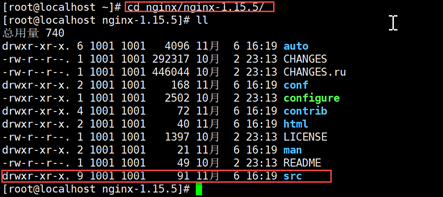
1.2 编译安装
# 配置:这里需要安装额外的模块 ./configure --prefix=/usr/local/nginx --with-http_ssl_module --with-stream --with-mail=dynamic # 编译 make # 安装 make install
以下是安装的结果
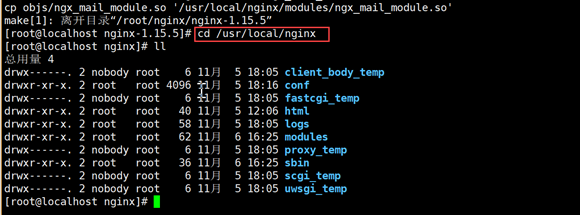
1.3 创建软链接
ln -s /usr/local/nginx/sbin/nginx /usr/local/bin
如上所述,这样可以不用再设置环境变量
1.4 证书相关
为了增强项目的安全性,有时需要将http访问转为https访问。通过对nginx中ssl模块进行设置,可以实现这一点。通常,这需要向CA申请安全证书(常用免费证书:https://letsencrypt.org/
1.4.1 证书的生成
在root目录下建立certs文件夹,切换到该文件夹,依次运行以下命令:
# 建立服务器私钥(过程需要输入密码,请记住这个密码)生成RSA密钥 openssl genrsa -des3 -out testwebcert.key 1024 # 生成一个证书请求 需要依次输入国家,地区,组织,email,common name等,common name可以写你的名字或者域名。如果为了https申请,必须和域名吻合,否则会引发浏览器警报。 openssl req -new -key testwebcert.key -out testwebcert.csr # 生成不需要密码的key openssl rsa -in testwebcert.key -out testwebcert_nopwd.key # 生成crt文件 openssl x509 -req -days 365 -in testwebcert.csr -signkey testwebcert_nopwd.key -out testwebcert.crt
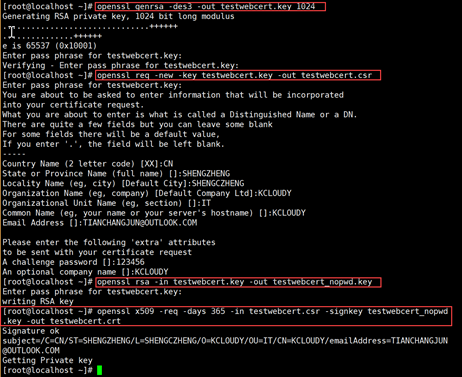
1.4.2 证书的位置
将证书复制到 /etc/ssl/certs/ 目录
cp testwebcert.crt /etc/ssl/certs/ cp testwebcert_nopwd.key /etc/ssl/certs/testwebcert.key
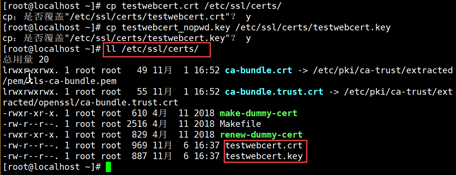
1.4.3 迪菲-赫尔曼密钥交换
一般来说,之后修改nginx.conf配置文件就可以了。为了进一步增强安全性,可以进行迪菲-赫尔曼密钥交换,在 /etc/ssl/certs/ 目录中
openssl dhparam -out dhparam.pem 4096
以下是生成的文件

1.5 nginx配置文件相关
1.5.1 自定义 proxy.conf 文件
vi /usr/local/nginx/conf/proxy.conf
在 /usr/local/nginx/conf/ 目录下新建 proxy.conf 文件,后面会在nginx.conf中引用此文件。
proxy_redirect off; proxy_set_header Host $host; proxy_set_header X-Real-IP $remote_addr; proxy_set_header X-Forwarded-For $proxy_add_x_forwarded_for; proxy_set_header X-Forwarded-Proto $scheme; client_max_body_size 10m; client_body_buffer_size 128k; proxy_connect_timeout 90; proxy_send_timeout 90; proxy_read_timeout 90; proxy_buffers 32 4k;
1.5.2 创建存放应用配置目录:/usr/local/nginx/conf/conf.d
mkdir /usr/local/nginx/conf/conf.d/

1.5.3 修改 nginx.conf 文件
vi /usr/local/nginx/conf/nginx.conf
修改 /usr/local/nginx/conf/ 目录下的nginx.conf文件,着重点已经使用了不同的颜色进行标注
worker_processes 1; events { worker_connections 1024; } http { include proxy.conf; include /usr/local/nginx/conf/conf.d/*.conf; include mime.types; default_type application/octet-stream; limit_req_zone $binary_remote_addr zone=one:10m rate=5r/s; server_tokens off; sendfile on; #tcp_nopush on; keepalive_timeout 29; client_body_timeout 10; client_header_timeout 10; send_timeout 10; #如果为应用单独配置conf的话,得注释掉 upstream testweb{ server localhost:5000; } server { listen 80; add_header Strict-Transport-Security max-age=15768000; return 301 https://$host$request_uri; } # HTTPS server # server { listen *:443 ssl; server_name localhost; ssl_certificate /etc/ssl/certs/testwebcert.crt; ssl_certificate_key /etc/ssl/certs/testwebcert.key; ssl_protocols TLSv1.1 TLSv1.2; ssl_prefer_server_ciphers on; ssl_dhparam /etc/ssl/certs/dhparam.pem; ssl_ciphers "EECDH+AESGCM:EDH+AESGCM:AES256+EECDH:AES256+EDH"; ssl_ecdh_curve secp384r1; ssl_session_cache shared:SSL:10m; ssl_session_tickets off; ssl_stapling on; #ensure your cert is capable ssl_stapling_verify on; #ensure your cert is capable add_header Strict-Transport-Security "max-age=63072000; includeSubdomains; preload"; add_header X-Frame-Options SAMEORIGIN; add_header X-Content-Type-Options nosniff;
#如果单独为应用配置Conf的话,得注释掉 #Redirects all traffic location / { proxy_pass http://testweb; limit_req zone=one burst=10 nodelay; limit_req_status 503; } } }
1.5.4 多应用配置
1.5.4.1 为每个站点创建独立的配置文件
vi /usr/local/nginx/conf/conf.d/testweb.conf
配置文件下载地址(包括:主配置文件-nginx.conf、反向代理-proxweb.conf、常用站点配置-normalweb.conf、https站点配置-sslweb.conf、静态文件配置-imageweb.conf)
配置文件格式如下:
server { #注意这里,要把默认的那个default_server去掉,因为我们在下面要单独配置域名访问,所以这里不要留default_server,不然会报错。 listen 80; #这里写你想设置的域名,可以写多个,与名之间用空格隔开 server_name testweb.com; # Load configuration files for the default server block. location / { proxy_store off; proxy_redirect off; proxy_pass http://localhost:5000; proxy_http_version 1.1; proxy_set_header Upgrade $http_upgrade; proxy_set_header Connection keep-alive; proxy_set_header Host $http_host; proxy_set_header X-Forwarded-For $proxy_add_x_forwarded_for; proxy_set_header X-Real-IP $remote_addr; proxy_cache_bypass $http_upgrade; } access_log /var/log/testweb_access.log main; error_page 404 /404.html; location = /404.html { root /usr/local/nginx/html; } # redirect server error pages to the static page /50x.html error_page 500 502 503 504 /50x.html; location = /50x.html { root /usr/local/nginx/html; } }
1.5.4.2 验证及重启Nginx
nginx –t
nginx –s reload
1.5.4.3 配置文件配置好了之后,还需要在linux下面的hosts文件下面加上以上域名
vi /etc/hosts
127.0.0.1 testweb.com
1.5.4.4 如果我们是要在windows下面访问虚拟机里面的linux下面的网站,那么还要在windows下面配置hosts文件,所有的域名都指向linux服务器,例如:
192.168.59.99 testweb.com
1.5.4.5 相关Error
nginx: [emerg] a duplicate default server for 0.0.0.0:80 in /usr/local/nginx/conf/conf.d/
配置文件testweb.conf中listen 80 后面有空字符,删除即可。
1.6 nginx 开机自动启动
1.6.1 设置nginx自启动,在/lib/systemd/system/ 目录下创建一个服务文件
vi /lib/systemd/system/nginx.service
注意,这里的路径是 /lib/systemd/system/ ,而非上面testweb项目自启动服务文件所在的 /etc/systemd/system/ 这一点值得注意。
[Unit] Description=nginx - high performance web server After=network.target remote-fs.target nss-lookup.target [Service] Type=forking ExecStart=/usr/local/nginx/sbin/nginx -c /usr/local/nginx/conf/nginx.conf ExecReload=/usr/local/nginx/sbin/nginx -s reload ExecStop=/usr/local/nginx/sbin/nginx -s stop [Install] WantedBy=multi-user.target

1.6.2 文件编辑完成之后,运行以下命令启动服务:
systemctl enable nginx.service
# 启动nginx服务
systemctl start nginx.service
# 查看状态
systemctl status nginx.service
结果如下:

这里之所以有一个警告,是因为我们使用的证书是自己生成的,而不是正式的证书。
1.6.3 对配置文件修改后需要重启服务,执行以下命令:
# 如果修改了文件,这个是必须的 systemctl daemon-reload # 重新启动服务 systemctl restart nginx.service
1.7 访问相关
由于在nginx.conf中配置了 add_header Strict-Transport-Security max-age=15768000; 即只能允许https访问, 因此输入http://192.168.56.99会提示错误。
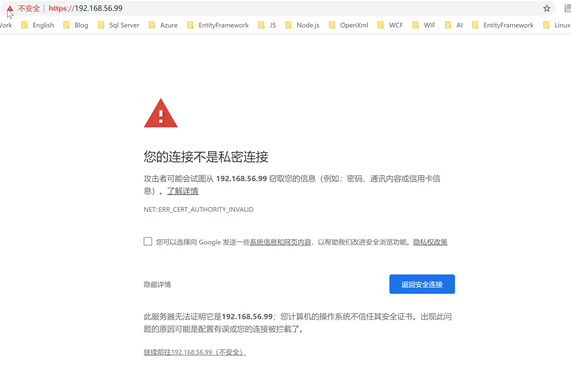
继续前往(Chrome)/添加例外(Firefox)后,正常的访问结果如下图所示,之所以会出现这样的提示,是因为所用的证书是自己生成的。

1.8 相关问题
l 杀死nginx进程
解决方案:查询nginx主进程号:ps -ef | grep nginx ;杀死进程:kill -QUIT 主进程号

l 服务器重启之后,执行 nginx -t 是没问题的,然而在执行 nginx -s reload 的时候报错:nginx: [error] invalid PID number "" in "/usr/local/nginx/logs/nginx.pid"

解决方案
nginx -c /usr/local/nginx/conf/nginx.conf
nginx -s reload





 浙公网安备 33010602011771号
浙公网安备 33010602011771号